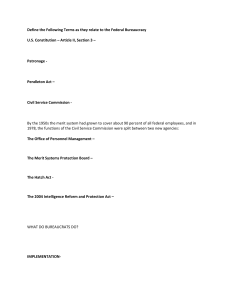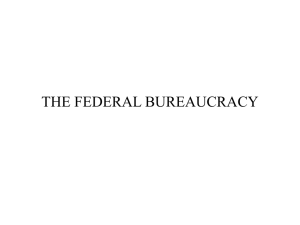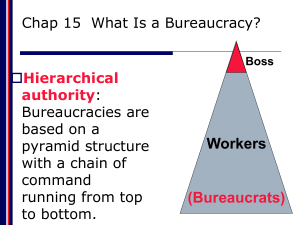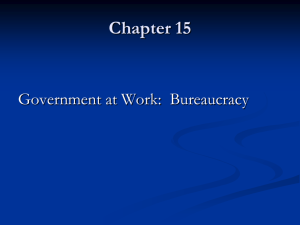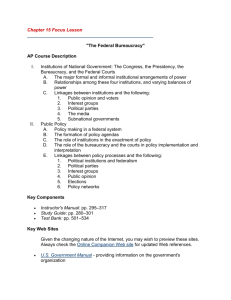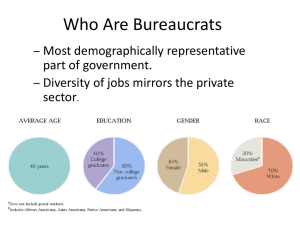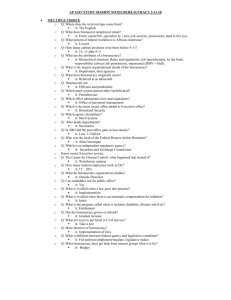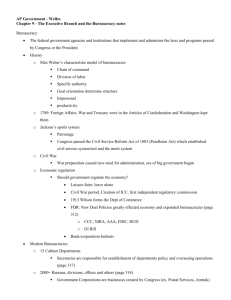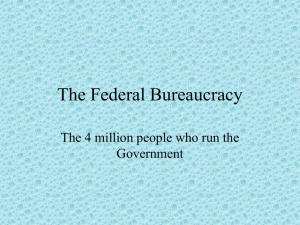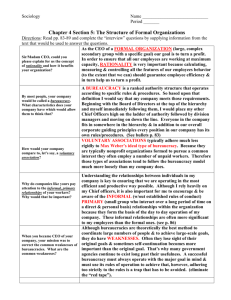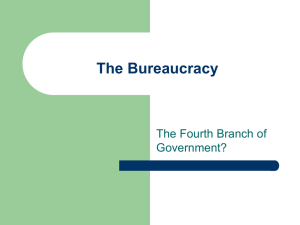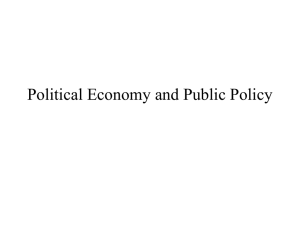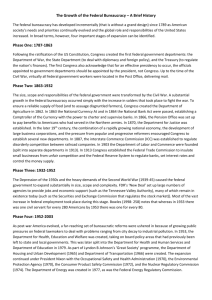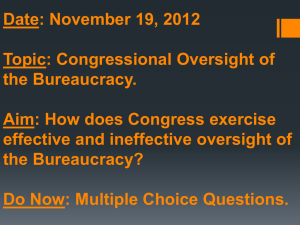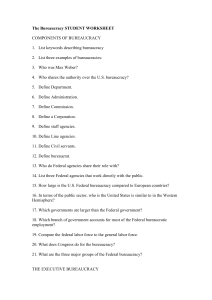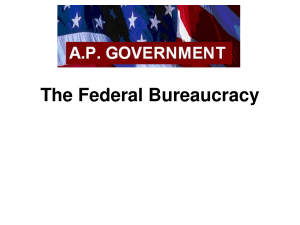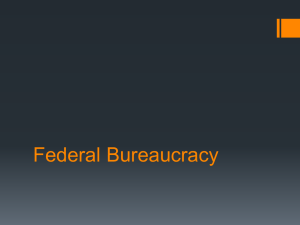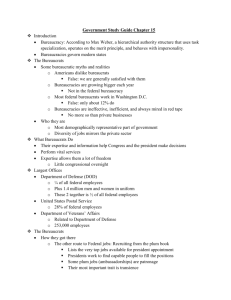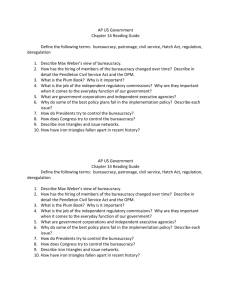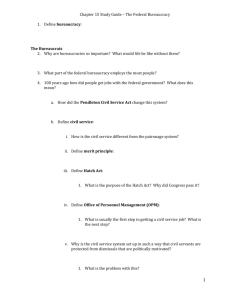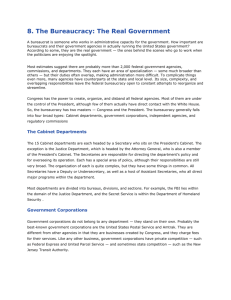The Bureaucracy Quiz (15)
advertisement
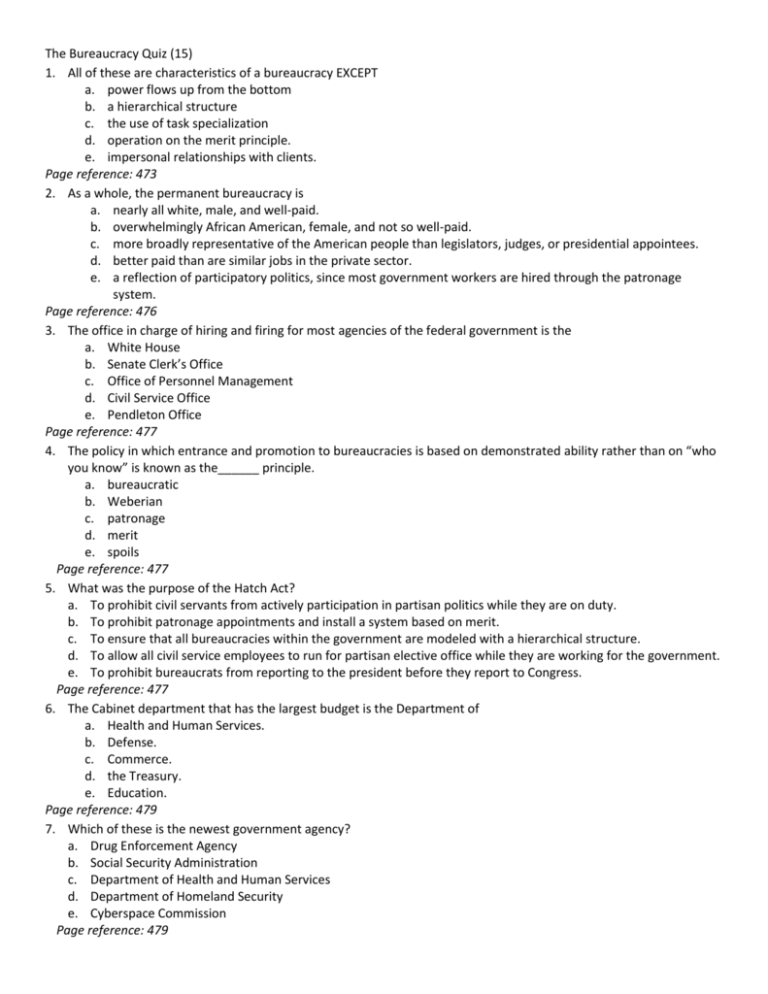
The Bureaucracy Quiz (15) 1. All of these are characteristics of a bureaucracy EXCEPT a. power flows up from the bottom b. a hierarchical structure c. the use of task specialization d. operation on the merit principle. e. impersonal relationships with clients. Page reference: 473 2. As a whole, the permanent bureaucracy is a. nearly all white, male, and well-paid. b. overwhelmingly African American, female, and not so well-paid. c. more broadly representative of the American people than legislators, judges, or presidential appointees. d. better paid than are similar jobs in the private sector. e. a reflection of participatory politics, since most government workers are hired through the patronage system. Page reference: 476 3. The office in charge of hiring and firing for most agencies of the federal government is the a. White House b. Senate Clerk’s Office c. Office of Personnel Management d. Civil Service Office e. Pendleton Office Page reference: 477 4. The policy in which entrance and promotion to bureaucracies is based on demonstrated ability rather than on “who you know” is known as the______ principle. a. bureaucratic b. Weberian c. patronage d. merit e. spoils Page reference: 477 5. What was the purpose of the Hatch Act? a. To prohibit civil servants from actively participation in partisan politics while they are on duty. b. To prohibit patronage appointments and install a system based on merit. c. To ensure that all bureaucracies within the government are modeled with a hierarchical structure. d. To allow all civil service employees to run for partisan elective office while they are working for the government. e. To prohibit bureaucrats from reporting to the president before they report to Congress. Page reference: 477 6. The Cabinet department that has the largest budget is the Department of a. Health and Human Services. b. Defense. c. Commerce. d. the Treasury. e. Education. Page reference: 479 7. Which of these is the newest government agency? a. Drug Enforcement Agency b. Social Security Administration c. Department of Health and Human Services d. Department of Homeland Security e. Cyberspace Commission Page reference: 479 8. The parts of the federal bureaucracy with responsibility for different sectors of the economy, and making and enforcing rules designed to protect the public interest, are the a. independent executive agencies. b. independent regulatory commissions. c. commercial ministries. d. government corporations. e. cabinet departments. Page reference:480- 482 9. The Federal Reserve Board is an examples of a a. dependent presidential board. b. independent regulatory commissions. c. government corporation. d. Cabinet department. e. independent executive agency. Page reference: 481-482 10. Most regulatory agencies adopt specific ________ to carry out a policy, based on what they believe was the intended purpose of the specific policy at hand. a. guidelines b. iron triangles c. incentive systems d. mandates e. merit principles Page reference: 495 11. Congress tries to control the bureaucracy through each of the following EXCEPT a. rewriting legislation. b. influencing the appointment of agency heads. c. holding hearings. d. issuing congressional orders. e. both a and b. Page reference: 499 12. The agency charged with governing banks and regulating the supply of money and interest rates is the a. Federal Communications Commission. b. National Security Council. c. Federal Reserve Board. d. National Labor Relations Board. e. Department of the Treasury. Page reference: 481 13. Which of the following statements about independent regulatory commissions is FALSE? a. Regulatory commission members cannot be fired by the president. b. Regulatory commissions consist of five to ten members. c. Regulatory commission members are appointed by the president and confirmed by the Senate. d. Regulatory commission members may not be drawn from the ranks of present or former employees of the regulated industry. e. none of the above Page reference: 480-482 14. Which of the following would not be considered a street-level bureaucrat? a. a municipal court judge b. an assistant secretary in the Department of Transportation c. a welfare worker d. a mail carrier who delivers mail exclusively in a high-rise building e. a police officer Page reference: 488 15. The first regulatory agency created in the US was the a. Federal Trade Commission b. Federal Communications Commission c. Interstate Commerce Commission d. National Labor Relations Board e. Securities and Exchange Commission Page reference: 495 16. When Congress passes regulatory legislation for which it has established goals, it then a. grants power to regulatory agencies to develop guidelines and enforce compliance. b. assigns responsibility for administration to regulatory agencies and responsibility for enforcement to the courts. c. establishes the guidelines that regulatory agencies must implement. d. grants interest groups the power to develop the rules governing the new policy. e. authorizes the president to use his administrative discretion to implement the legislation. Page reference: 495 17. Executive orders are issued by a. independent regulatory agencies. b. any federal agency or department. c. Congress. d. members of the Senior Executive Service. e. the president. Page reference: 498 18. To limit bureaucratic discretion and make its instructions clearer, Congress can a. deregulate. b. write new and more detailed legislation. c. hold congressional hearings. d. reregulate. e. threaten to cut an agency's budget. Page reference: 499 19. A(n) ________ consists of an administrative agency, an interest group, and a congressional committee or subcommittee. a. issue network b. independent executive agency c. triumvirate d. administrative discretion triad e. "iron triangle" Page reference: 500 20. Which of the following statements about bureaucracies and the scope of government is FALSE? a. When the president and Congress chose to deregulate certain areas of the economy or cut taxes, the bureaucracy prevented them from doing so. b. The federal bureaucracy has actually shrunk in size relative to the population it serves. c. The bureaucracy is now expected to play an active role in dealing with social and economic problems. d. The federal bureaucracy has not grown over the past two generations. e. none of the above Page reference: 502-503
